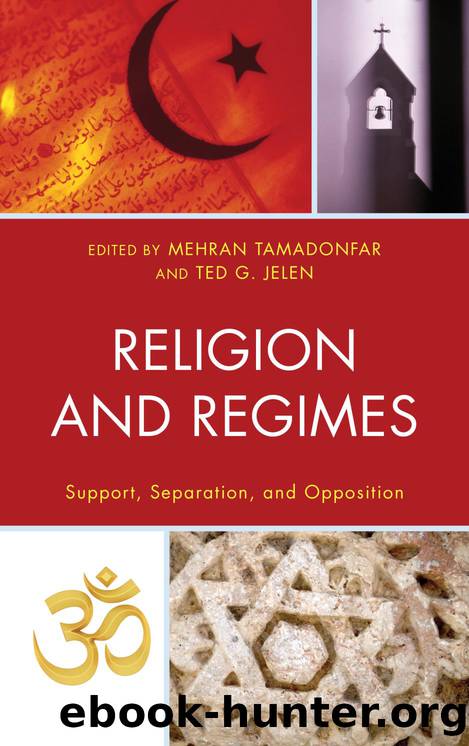Religion and Regimes by unknow

Author:unknow
Language: eng
Format: epub
Tags: undefined
Publisher: Lexington Books/Fortress Academic
Published: 2012-08-15T00:00:00+00:00
The Demise of the Secular Order
With Nehruâs death in 1964, the secular consensus began to unravel. Although Nehruâs daughter, Indira Gandhi, became Prime Minister in 1966 and initially embraced the Congress Partyâs early commitments to social justice, democracy, and tolerance, these commitments were readily abandoned in the 1970s. Particularly after the turmoil of the Emergency Period (1975â1977, when Mrs. Gandhi suspended the constitution and instituted an era of authoritarian rule), Indira recognized the utility of abandoning her earlier left-wing populism for a reformulated right-wing populism. A central feature of this was a nationalist discourse imbued with religious themes. This strategy was evident on the campaign trail, where Mrs. Gandhi utilized a rhetoric of religious communalism in order to appeal to the majoritarian sentiments of the Hindu population. To this end, she highlighted the danger of regional (and religious) separatismâfocusing particularly on Sikhs in Punjab and Muslims in Kashmirâand linking religious difference to state security. By demonizing minority populations, and articulating the danger within a discourse of ethnic nationalism, Indira was able to attract Hindu voters and effectively co-opt the ideas and supporters of Hindu nationalism (see Hasan 1991).
Indiraâs religious politics were particularly evident in her depiction of regional political disputes as existential threats to the Hindu nation. In early 1983, for example, she denigrated Muslim leaders in Kashmir as âanti-nationalâ and âpro-Pakistaniâ and made the regional conflicts in Punjab and Kashmir central features of the 1984 Parliamentary campaign (see Joshi 1999). In the context of these debates and political campaigns, religion was invoked as a means of appealing to Hindu majority voters and attracting supporters of the RSS and other communal organizations. Political conflicts between the regions and the central government were subsequently characterized as religious and national in nature, and minority claims for fair treatment denigrated and treated as an assault upon the integrity of the nation. In one speech, Gandhi claimed that in âcertain places [i.e., Kashmir and Punjab]â minority populations had been guaranteed rights and privileges while the âmajority community was being suppressed.â[4] In another speech, she argued that âthe Hindu Dharma was under attackâ and appealed to her audience to save Hindu tradition âfrom the attack that was coming from the Sikhs, the Muslims, and othersâ (Kothari 1989, 247). As commentator James Manor noted, âAlthough it may seem difficult to believe that Hindu Chauvinism and anti-Sikh sentiments were important elements in the Congress-I elections, it was, in fact, the caseâ (Kohli 1988, 81).
The embrace of an exclusive religious politics by the Congress Party leadership was driven in part by electoral considerations. The failure to raise living standards, the excesses committed by Congress Party leaders (including Gandhiâs son Sanjay) during Emergency rule, and rampant corruption had all undermined the Partyâs traditional supporters among the rural poor, Muslims, and lower caste Hindus. Hence, one can see Indiraâs religious turn as an opportunistic strategy to appeal to the majority populations of the so-called âHindi Heartland.â Appealing to the sentiments of upper caste Hindus who perceived themselves as being discriminated
Download
This site does not store any files on its server. We only index and link to content provided by other sites. Please contact the content providers to delete copyright contents if any and email us, we'll remove relevant links or contents immediately.
| Amish | Catholicism |
| Christian Science | Jehovah's Witness |
| Mennonite | Messianic Judaism |
| Mormonism | Orthodoxy |
| Protestantism |
Under the Banner of Heaven: A Story of Violent Faith by Jon Krakauer(1715)
The Early Centuries - Byzantium 01 by John Julius Norwich(1672)
The Amish by Steven M. Nolt(1507)
Taken by J. C. Owens(1505)
In Spirit and Truth (In Spiritu Et Veritate Series) by Reed Zoe(1495)
Play It as It Lays by Joan Didion(1447)
The Apogee - Byzantium 02 by John Julius Norwich(1387)
The Last Man in Russia by Oliver Bullough(1338)
A History of the Amish by Steven M. Nolt(1233)
David Sedaris Diaries by David Sedaris(1190)
Leaving the Witness by Amber Scorah(1180)
Tears of the Silenced: A True Crime and an American Tragedy; Severe Child Abuse and Leaving the Amish by Misty Griffin(1157)
Fallen by unknow(1151)
The Dance of Change by unknow(1128)
The Angel of Forest Hill by Cindy Woodsmall(1102)
The Best of Amish Cooking by Phyllis Pellman Good(1091)
The Ariana Trilogy by Rachel Ann Nunes(1082)
Deep Blue by unknow(1078)
Escape by Carolyn Jessop & Laura Palmer(1066)
